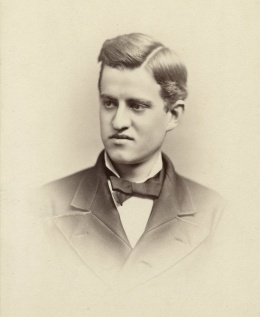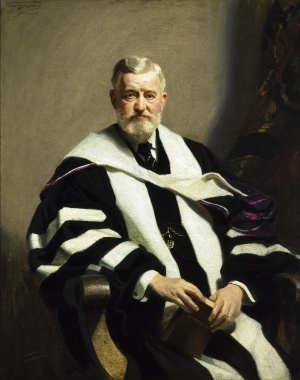Henry Clay Folger: Difference between revisions
m (Fixed typo) |
m (Text replacement - "<references>" to "<references />") |
||
| Line 40: | Line 40: | ||
==Notes== | ==Notes== | ||
<references> | <references /> | ||
[[Category:Folger Shakespeare Library]] | [[Category:Folger Shakespeare Library]] | ||
Latest revision as of 11:19, 27 August 2018
Henry Clay Folger (June 18, 1857-June 11, 1930) was born in New York City to Henry Clay Folger, Sr., and Eliza Jane Clark Folger. Through his ancestor Peter Foulger, who settled in Massachusetts in the late 1620s,[1] Folger was distantly related to Founding Father Benjamin Franklin, astronomer Maria Mitchell, and social reformer Lucretia Mott.[2] He is often colloquially referred to as "Mr. Folger" by staff of the Folger Shakespeare Library.
Early life

As a child, Henry's family moved often; before Henry matriculated at Amherst College, his family had lived in twelve different residences in Manhattan and Brooklyn, as well as a home upstate in Troy, New York. From 1873 to 1875, he attended Adelphi Academy, a coeducational prep school in Brooklyn founded in part by Henry Ward Beecher. At Adelphi, Henry made the acquaintance of businessman Charles Pratt, who would long serve as a mentor to Henry, as well as of Pratt's son Charles Jr., with whom Henry attended Amherst.
Henry began classes at Amherst in fall of 1875. He joined the Alpha Delta Phi fraternity and sang in the College's Glee Club, which performed in Boston and Brooklyn. He also participated in a variety of oratorical essay contests; he was one of the Kellogg Prize winners in 1876 for the essay, Pericles before the Aeropagus, and took first prize for an 1879 essay on Tennyson. Henry modeled his oratorical style on Daniel Webster. As a senior, Henry performed as Dick Deadeye in Amherst's production of HMS Pinafore, a role that later prompted Emily Jordan Folger to nickname her husband "Dick".
Marriage to Emily Clara Jordan
Henry was first introduced to Emily Clara Jordan as early as 1880 by siblings Charles and Lillie Pratt, with whom Henry and Emily were close friends, respectively. They were married at Westminster Presbyterian Church on October 6, 1885. The couple spent annual vacations at The Homestead resort in Hot Springs, Virginia. They had no children.
Career
After graduating from Amherst in 1879, Henry attended Columbia Law School and worked for Charles Pratt, Sr., at Charles Pratt and Company. Upon his admission to the bar in 1881, he remained at the Standard Oil Company of New Jersey as the manufacturing committee's First Statistical Clerk. His methodical compilation and tracking of oil production statistics prompted his success in the company, and he became chairman of the manufacturing committee in 1899 and president of the Standard Oil Company of New York (Socony) in 1911, following the breakup of Standard Oil. He became chairman of the Socony board in 1923, and retired in 1928. He was well-known in the company for his Shakespeare collecting.
Collecting

Among the most remarkable items acquired by Henry and Emily during their forty years of collecting Shakespearean and Elizabethan materials are the Titus Andronicus quarto, the earliest copy of one of Shakespeare's works, the Vincent copy of the First Folio, and an immense amount of material related to the great Shakespearean actor David Garrick. Other notable items were featured in the exhibition A Shared Passion: Henry Clay Folger, Jr. and Emily Jordan Folger as Collectors.
The first rare book Henry purchased was a 1685 Fourth Folio, acquired in 1889 from Bangs and Company for $107.50. He purchased his first original First Folio in 1893. Henry kept an extensive want list to monitor his purchases and budget; he and Emily chose items to buy through careful monitoring of auction catalogues, which Emily would mark up with potential purchases later reviewed by Henry. Henry rarely attended auctions, using professional book dealers like A.S.W. Rosenbach and Henry Sotheran as middlemen to preserve his anonymity as a buyer. Henry also favored purchasing whole collections, as bulk purchases kept prices down for individual items. Among the collections Henry acquired was the Halliwell-Phillipps collection. He rarely consulted scholarly experts about his collecting, preferring to rely on Emily's expertise. If possible, he personally inspected items before buying them. After purchase, items were stored in Brooklyn Standard Oil warehouses, monitored by Emily, who managed an extensive card catalog of their collection.
The Folgers were members of various Shakespeare associations in England and the United States, including the Shakespeare Association of America, the National Shakespeare Federation, and the Oxford Bibliographic Society. In 1909, he established an essay contest at Amherst called the Shakespeare Prize. Winning essayists won cash prizes and their pieces joined the Folger collection.
The Folger Shakespeare Library
Henry and Emily began scouting for sites for a permanent repository for their collection in the early 1920s. Among the potential sites were Amherst, New York City, and Stratford-upon-Avon, before they decided on a plot of land near the Capitol in Washington, D.C., discovered during a layover at Union Station as they traveled to Hot Springs. Henry spent nine years purchasing the townhouses on the plot, known as Grant's row, which would have to be demolished before construction of the Library began.
Henry hired Paul Philippe Cret and Alexander Trowbridge as architects. The Folgers requested that the Elizabethan theater be placed at the east end of the building, farthest away from the Capitol. This theater was initially used for academic lectures, rather than theatrical productions. Henry also hired sculptor John Gregory to design the Shakespearean reliefs that decorate the building's facade.
Henry was alive for the laying of the building's cornerstone, but died two years before the opening of the Library. Upon Henry's death, the bulk of his estate was bequeathed to the Library in trust. His will also specified that a board of Trustees based at Amherst College administer the Library in perpetuity, and on October 31, 1930, the Trustees received the title to the Shakespeare Collection, as well as the real estate deed of the Library.
Later life and death
In May 1930, Henry was admitted to St. John's Hospital in Brooklyn for surgery on an enlarged prostate. He continued to work on the Library's construction while recovering. He later had a second operation to remove his prostate; soon after this operation, he died on June 11, 1830. His ashes were placed in a "mortuary urn niche" in what is now the Paster Reading Room, behind the bronze tablet engraved with To the Glory of William Shakespeare and the Greater Glory of God, flanked by his and his wife's painted portraits by Frank O. Salisbury.[3]
Notes
- ↑ The text of this article largely draws on the dual biography of the Folgers written by Stephen H. Grant, Collecting Shakespeare: The Story of Henry and Emily Folger. Baltimore: Johns Hopkins University Press, 2014.
- ↑ Kim Downs-Watson, "Peter Foulger: what we have discovered about a most remarkable man," Nantucket Historical Association, April 1983, 22.
- ↑ Letter from Paul Cret to Mrs. Folger, October 21, 1930, "We are sending you under separate cover, a red line print of our sheet SK-37, study of the bronze tablet that is to cover the mortuary urn niche...." (Folger Archives, Box 57)